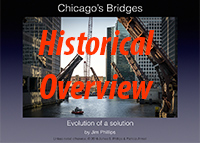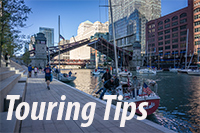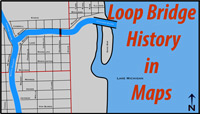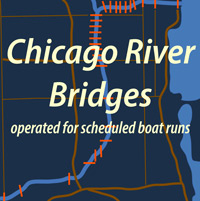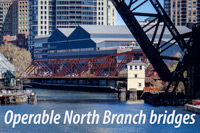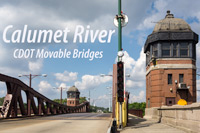Kinzie St Bridge

Looking north to the bridges at Kinzie St. from Lake St.
There are two bridges at Kinzie street - the CDOT bridge for the street and the raised Carroll Ave. railroad bridge owned and operated by the Union Pacific railroad.
Kinzie St. Bridge
The Kinzie Street crossing has had a long and storied history. From being the first bridge over the Chicago River (1832) to last movable bridge staffed by a full-time bridge operator on the Chicago River (1999).

Kinzie St bridge in 2015
The current bridge ended the swing bridge era when it opened on May 10, 1909. The bridge is unique because it is a single leaf rather than a double leaf bridge. Additionally, it is the easiest to access first generation Chicago-type bascule in the downtown area.
The defining characteristic of the first generation bridge is the hump-backed through truss that accommodates the rack and pinion gearing outside the truss. Subsequent generations of the Chicago-type bascule have an internal gearing set-up which allowed for the different types of supporting truss systems seen in the Loop bridges.
Some selected highlights from Kinzie St. bridge history:
1992 Flood
The background to this story involves the system of freight tunnels below the Loop. The tunnels were originally to be conduits for a new telephone system in 1898. The “conduits” turned into 40 ft deep tunnels that were large enough (7.5 ft high 6.75 ft wide) for a narrow gauge railway as well as telephone cables. The goal of these tunnels was to make small freight deliveries to businesses more efficient by avoiding the gridlock on the surface streets. Deliveries included non-liquid commodities shipped to wholesale and large retail customers, coal for building heating and ash removal.
The phone business folded in 1916, but by 1924 the railroad was serving sixty commercial buildings. Operations ceased in 1959. Starting in the 1970's, Chicago began leasing sections of the tunnel system for electrical and tele-communication conduits.
There are groups of pilings near bridge abutments that protect the bridges from passing vessels. In September of 1991, existing protective pilings were replaced at the Kinzie St. bridge. In this process, new pilings were driven in a slightly different place than the old ones. Unknown at the time, this difference in location was enough to damage the integrity of the soil / freight tunnel interface below the bridge. This damage led to a slow but steady leak which caused erosion of tunnel material.
In January 1992 while surveying the tunnel for possible routes to extend cable lines, Cable TV employees discovered knee-deep silt and water leaking through crumbling walls in the tunnel. Attempts to notify the appropriate city contact of the situation in a timely manner were unsuccessful. The report on the tunnel status was finally delivered in late February. Further bureaucratic delays in recognizing the problem and developing a solution insured the failure of the tunnel and subsequent flood.
On April 13, 1992 a section of the abandoned freight tunnel under the Kinzie St. bridge failed. Water was noticed pouring in the subbasement at the Merchandise Mart around 6 AM. Within an hour waters had reached City Hall and Marshall Field's (now Macy's). By 10 AM Commonwealth Edison began shutting power off around the Loop and evacuations began.
The tunnels were finally sealed and dewatered by the Army Corps of Engineers and returned to city control on May 22, 1992.
Bridge Raising
The Kinzie St. bridge had one of the lowest water clearances of CDOT's movable bridges on the Chicago River. The clearance was so low (about 12 ft.) that it had to be raised for tour boats and barges. This meant the bridge had to be staffed 24/7 for navigation interests and was raised about 5,000 times per year.
When the Kinzie St. bridge required a major rebuild in the late 1990's, Chicago Engineers decided to increase the bridge clearance by five feet as well. This change meant that the bridge no longer had to be staffed 24 hours making it the last Chicago River bridge with a full-time bridge operator.
The bridge construction process was similar to that used at Wells St. in 2013. The leaf was built off site about a quarter mile north of the Kinzie crossing.
When the time came to install the new leaf, it was floated in on a barge – raised up and bolted on. About a three day process. The rebuilt bridge opened in 1999.
From the “It's only funny if it didn't happen to you” department...
On August 8, 2004 an unsuspecting group of tourists on a architecture cruise had an unpleasant experience at the Kinzie St. bridge. They happened to be passing under the bridge at the same time a tour bus was crossing over.
On the surface, not all that unusual for different modes of transportation to cross at intersections. The unique feature of this event was the bus was dumping its sewage tanks on the bridge at the time. The open steel grate bridge deck provided little resistance to the muck as it doused the tourists on the boat.
The tour bus was chartered by the Dave Matthews Band. As penance, the group donated $50K each to Friends of the Chicago River and the Chicago Park District. In addition, the band settled a civil suit related to the incident for $250K.
This Joseph Strauss designed bridge opened in 1908 and it is the only bridge in the downtown area with an overhead counterweight.
The railroad line initially ran to Navy Pier. Over time the portions of the right-of-way were sold off / abandoned. The last customer for the rail service was the Chicago Sun-Times. Newsprint was carried via rail to the Sun-Time printing plant that was located where the Trump Tower is today. That operation was moved from the downtown area in 2001.
Even though the rail line is not in use, the Union Pacific railroad is reluctant to give up the right of way to the river crossing. Once a year the bridge is lowered and a Hi-rail truck driven across the bridge to preserve the right-of-way.
When the bridge is in its lowered position there is very little clearance for vessels, so it is left in the raised position.
More information can be found at Historicbridges.org for street bridge and railroad bridge.
****
Sources:
Bruce Moffat, The Chicago Freight Tunnels; MAS Context, Network – Issue 9 Spring 11; pp72-83
Jon Wren, The Great Chicago Flood, Structure Magazine; August 2007; pp35-40
“Bungling, buck-passing lead to disaster”; April 23, 1992; Chicago Tribune
“City regains control of tunnel”; May 22, 1992; Chicago Tribune
“New era dawns over Chicago River renovations to help curb ups, downs of its many bridges”; October 28, 1998; Chicago Tribune
Case Study: Bridging the Gap; Risi Stone Systems, 2006
Bus waste scuttles boat tour; August 9, 2004; Chicago tribune
Patrick McBriarty, Chicago River Bridges, University of Illinois Press, 2013, p 219
****

